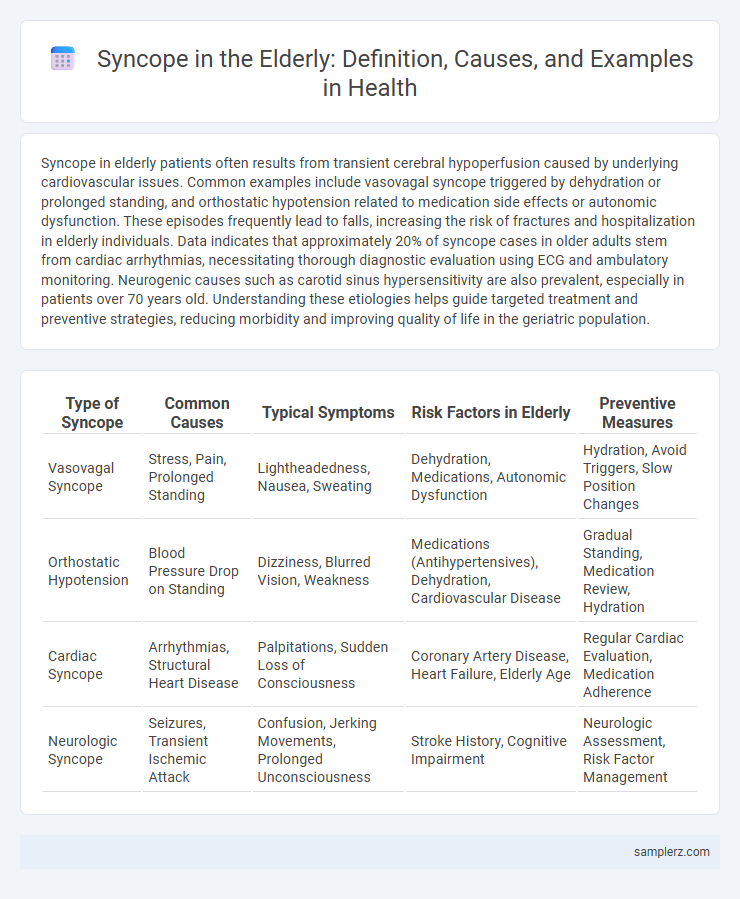Syncope in elderly patients often results from transient cerebral hypoperfusion caused by underlying cardiovascular issues. Common examples include vasovagal syncope triggered by dehydration or prolonged standing, and orthostatic hypotension related to medication side effects or autonomic dysfunction. These episodes frequently lead to falls, increasing the risk of fractures and hospitalization in elderly individuals. Data indicates that approximately 20% of syncope cases in older adults stem from cardiac arrhythmias, necessitating thorough diagnostic evaluation using ECG and ambulatory monitoring. Neurogenic causes such as carotid sinus hypersensitivity are also prevalent, especially in patients over 70 years old. Understanding these etiologies helps guide targeted treatment and preventive strategies, reducing morbidity and improving quality of life in the geriatric population.
Table of Comparison
| Type of Syncope | Common Causes | Typical Symptoms | Risk Factors in Elderly | Preventive Measures |
|---|---|---|---|---|
| Vasovagal Syncope | Stress, Pain, Prolonged Standing | Lightheadedness, Nausea, Sweating | Dehydration, Medications, Autonomic Dysfunction | Hydration, Avoid Triggers, Slow Position Changes |
| Orthostatic Hypotension | Blood Pressure Drop on Standing | Dizziness, Blurred Vision, Weakness | Medications (Antihypertensives), Dehydration, Cardiovascular Disease | Gradual Standing, Medication Review, Hydration |
| Cardiac Syncope | Arrhythmias, Structural Heart Disease | Palpitations, Sudden Loss of Consciousness | Coronary Artery Disease, Heart Failure, Elderly Age | Regular Cardiac Evaluation, Medication Adherence |
| Neurologic Syncope | Seizures, Transient Ischemic Attack | Confusion, Jerking Movements, Prolonged Unconsciousness | Stroke History, Cognitive Impairment | Neurologic Assessment, Risk Factor Management |
Common Causes of Syncope in Elderly Patients
Orthostatic hypotension, cardiac arrhythmias, and neurocardiogenic syncope are common causes of syncope in elderly patients, often triggered by blood pressure fluctuations and compromised cardiovascular function. Medication side effects, such as those from antihypertensives or diuretics, can exacerbate syncope risk by altering vascular tone and volume status. Chronic conditions like aortic stenosis and carotid sinus hypersensitivity also contribute significantly to syncopal episodes in this population.
Typical Presentations of Syncope Among Seniors
Syncope in elderly patients typically presents as sudden, transient loss of consciousness accompanied by an inability to maintain postural tone, often triggered by orthostatic hypotension, cardiac arrhythmias, or vasovagal responses. Typical presentations include brief episodes of lightheadedness, dizziness, and fall-related injuries due to impaired cerebral perfusion. Identifying underlying cardiovascular or neurological causes is crucial for preventing recurrent syncope and reducing morbidity in seniors.
Case Study: Vasovagal Syncope in Older Adults
Vasovagal syncope in older adults frequently results from a sudden drop in heart rate and blood pressure, leading to temporary loss of consciousness, as highlighted in recent case studies. An 80-year-old patient presented with recurrent fainting episodes triggered by prolonged standing and emotional stress, diagnosed through tilt-table testing confirming vasovagal reflex. Management strategies include lifestyle modifications, hydration, and tailored pharmacologic therapies to prevent recurrent syncope and associated fall risks in the elderly population.
Orthostatic Hypotension-Induced Fainting in the Elderly
Orthostatic hypotension-induced fainting is a common cause of syncope in elderly patients, characterized by a sudden drop in blood pressure upon standing. This condition often results from impaired autonomic regulation, dehydration, or medication side effects such as antihypertensives and diuretics. Timely diagnosis and management, including hydration and medication adjustment, are crucial to prevent falls and related complications in this population.
Cardiac Syncope: Warning Signs in Senior Populations
Cardiac syncope in elderly patients often presents with sudden loss of consciousness due to arrhythmias or structural heart disease such as aortic stenosis or cardiomyopathy. Warning signs include palpitations, chest pain, shortness of breath, and abrupt episodes of fainting without warning. Immediate evaluation with electrocardiogram (ECG) and echocardiography is critical to prevent serious complications like sudden cardiac arrest in senior populations.
Medication-Related Syncope Examples in Geriatrics
Medication-related syncope in elderly patients often arises from antihypertensives like beta-blockers and diuretics, which can cause excessive hypotension and dehydration. Other common agents include benzodiazepines and antidepressants, known to induce orthostatic hypotension and impair autonomic regulation. Regular medication reviews and dose adjustments are critical in preventing syncope episodes in geriatrics.
Postprandial Syncope: Recognizing Symptoms After Meals
Postprandial syncope in elderly patients commonly occurs within an hour after eating, often triggered by a significant drop in blood pressure as blood flow increases to the digestive system. Symptoms include dizziness, lightheadedness, blurred vision, and occasional fainting episodes, which require prompt evaluation to rule out underlying cardiovascular or autonomic nervous system disorders. Management involves dietary modifications such as smaller, more frequent meals and monitoring blood pressure to prevent recurrent syncope and reduce fall risk.
Neurological Causes of Syncope in Elderly People
Neurological causes of syncope in elderly people often include transient ischemic attacks, seizures, and carotid sinus hypersensitivity, with each condition disrupting normal cerebral blood flow or electrical activity. These events can lead to a sudden loss of consciousness, posing significant risks in elderly patients due to underlying comorbidities like atherosclerosis and neurodegenerative diseases. Accurate diagnosis through neuroimaging and electrophysiological studies is essential for effective management and prevention of recurrent syncopal episodes.
Falls and Injuries from Syncope in Aging Individuals
Syncope in elderly individuals often leads to falls, resulting in significant injuries such as hip fractures and traumatic brain injuries. Studies show that approximately 30% of syncope-related falls in older adults require hospitalization due to severity. Effective management includes fall prevention strategies and timely diagnosis to reduce morbidity and improve quality of life in aging populations.
Preventive Strategies for Syncope in Elderly Patients
Effective preventive strategies for syncope in elderly patients include regular cardiovascular assessments to detect arrhythmias and orthostatic hypotension screening to monitor blood pressure fluctuations. Implementing medication reviews helps reduce polypharmacy risks, particularly from antihypertensives and diuretics. Encouraging lifestyle modifications such as adequate hydration, balance training, and fall prevention programs further minimizes syncope-related injuries.

example of syncope in elderly Infographic
 samplerz.com
samplerz.com